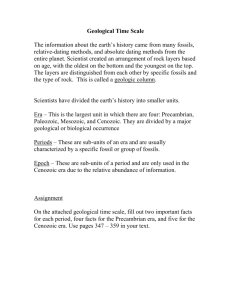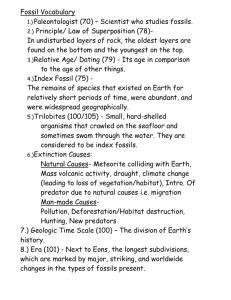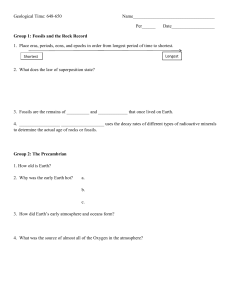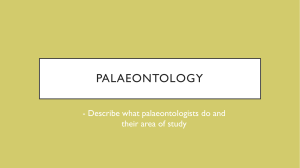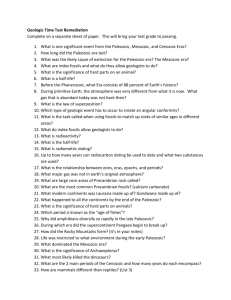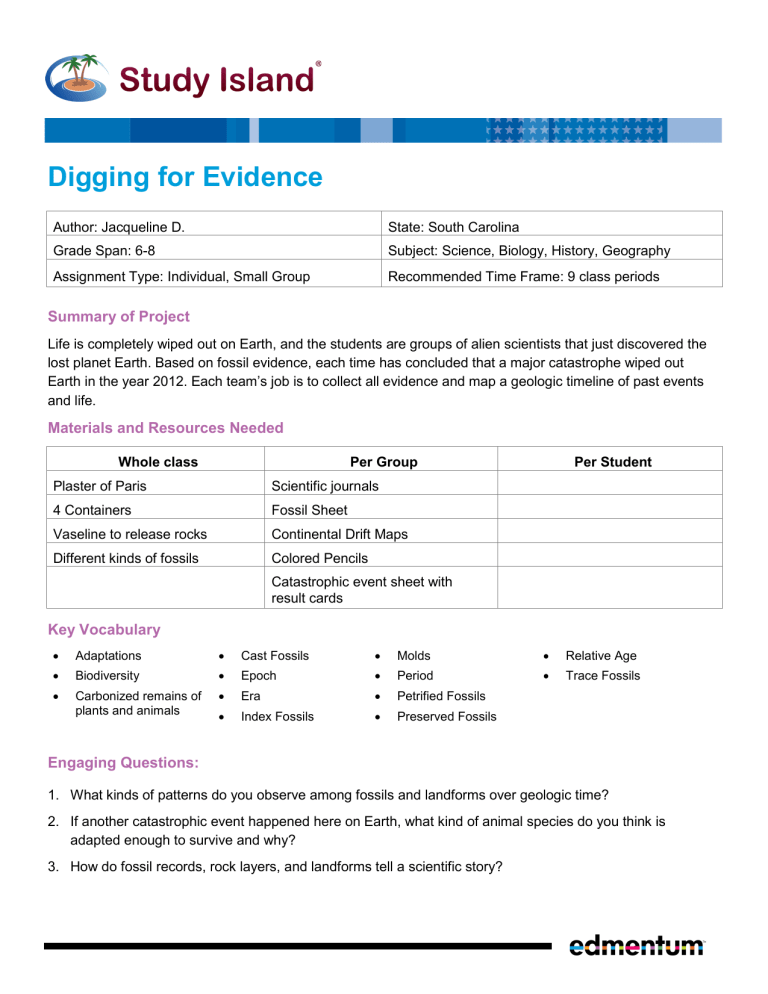
Digging for Evidence Author: Jacqueline D. State: South Carolina Grade Span: 6-8 Subject: Science, Biology, History, Geography Assignment Type: Individual, Small Group Recommended Time Frame: 9 class periods Summary of Project Life is completely wiped out on Earth, and the students are groups of alien scientists that just discovered the lost planet Earth. Based on fossil evidence, each time has concluded that a major catastrophe wiped out Earth in the year 2012. Each team’s job is to collect all evidence and map a geologic timeline of past events and life. Materials and Resources Needed Whole class Per Group Plaster of Paris Scientific journals 4 Containers Fossil Sheet Vaseline to release rocks Continental Drift Maps Different kinds of fossils Colored Pencils Per Student Catastrophic event sheet with result cards Key Vocabulary Adaptations Cast Fossils Molds Relative Age Biodiversity Epoch Period Trace Fossils Carbonized remains of plants and animals Era Petrified Fossils Index Fossils Preserved Fossils Engaging Questions: 1. What kinds of patterns do you observe among fossils and landforms over geologic time? 2. If another catastrophic event happened here on Earth, what kind of animal species do you think is adapted enough to survive and why? 3. How do fossil records, rock layers, and landforms tell a scientific story? Implementing the Activity Pre-make the following: 4 layers of rock beds for each group of students from Plaster of Paris. Laminate the fossil sheet before cutting. You will need one fossil sheet per group. A copy of the Continental Drift Maps for each student to cut and put in their journals. A copy of the catastrophic event sheet laminated for each group. Give the students the homework assignment and book template to create their own journal before day 1. (Inform the students that each entry must be numbered according to the activity and dated.) Teacher’s role: Monitor daily learning. Clear up any misconceptions and work one-on-one with groups that need extra assistance. Grouping suggestion: Group students with at least one high-performing student and one low-performing student in each group. Do not place more than 4 students in a group. Bedrock directions (for 1 group of students) Materials: 4 x 4 shallow rectangular containers (at least 4) Vaseline Plaster of Paris Water Wooden stir stick Red, blue, yellow, green food dye Procedure: 1. Lightly coat the bottom and sides of all four containers with Vaseline 2. Mix Plaster of Paris in the containers, enough to be 1 inch deep 3. Color each of the four containers different colors 4. Let set for at least 24 hours 5. Gently pop the slabs out Red: Precambrian Period; Blue: Paleozoic Era; Green: Mesozoic Era; Yellow: Cenozoic Era End Result Each student will create a scientific journal with their findings, including illustrations to support the ideas and discoveries. Each team member will submit their own journal. On the last day of the unit, each team will present findings and proposals about what happened to eliminate Earth to their alien peers. studyisland.com info@studyisland.com 2 Rubric Activity 1 point 2 points 3 points One Activity is incomplete and has many errors. Activity had a few errors, but overall all it is complete and correct. Activity was complete and free of errors. Two Activity is incomplete and has many errors. Activity had a few errors, but overall all it is complete and correct. Activity was complete and free of errors. Three Activity is incomplete and has many errors. Activity had a few errors, but overall all it is complete and correct. Activity was complete and free of errors. Four Activity is incomplete and has many errors. Activity had a few errors, but overall all it is complete and correct. Activity was complete and free of errors. Five Activity is incomplete and has many errors. Activity had a few errors, but overall all it is complete and correct. Activity was complete and free of errors. Six Activity is incomplete and has many errors. Activity had a few errors, but overall all it is complete and correct. Activity was complete and free of errors. Seven Activity is incomplete and has many errors. Activity had a few errors, but overall all it is complete and correct. Activity was complete and free of errors. Eight Activity is incomplete and has many errors. Activity had a few errors, but overall all it is complete and correct. Activity was complete and free of errors. Nine Activity is incomplete and has many errors. Activity had a few errors, but overall all it is complete and correct. Activity was complete and free of errors. Grading Scale 27 points: 100% 26 – 24 points: 94 % 23 – 21 points: 88 % 20 – 18 points: 78% Less than 18 points: 68% For Differentiated Instruction Tactile learner: manipulate event cards and catastrophe cards, manipulate fossils and rock layers Logical/Mathematical: Order events, create timelines, look for patterns Visual learner: Timeline, manipulate fossils, event cards Musical/Rhythmic: presentations Visual/Spatial: Timeline, patterns, manipulate fossils and rock layers studyisland.com info@studyisland.com 3 Scenario Life is completely wiped out on Earth. You are an alien scientist team that discovered the lost planet Earth. Based on fossil evidence, your team has concluded that a major catastrophe wiped out Earth in the year 2012.Your job is to collect all evidence and map a geologic time line of past events and life. End Product You will create a scientific journal that details your findings. Include illustrations to support your ideas and discoveries. Each team member needs to submit their own journal. On the last day of the unit, each team will present their findings and proposals about what happened to eliminate Earth to their alien peers. studyisland.com info@studyisland.com 4 Day 1 and 2 Standard: Explain how Earth’s history has been influenced by catastrophes. (comets, climate change, and volcanic activity) Objectives: Make inferences based on observations. Explain how plate tectonics has affected continental plates. Explain the relationship between plate tectonics, catastrophic events, and Geologic time. Activity One: 1. Students will be given a geologic map that shows the continental drift for each time period. 2. Based on the plate changes, students will draw in landforms on the maps and symbols that indicate earthquake zones. 3. Students will infer what kind of catastrophic events may have occurred based on each plate during each era. Activity Two: 1. 2. 3. 4. 5. Students are given cut and laminated catastrophic event cards with dates and time periods. On another set of cards students are given results/ effects. Students will match up the events with the results in order from oldest event to most recent. In their journals, students will create a time line of events and results. Using the previous map activity, students will write a relationship statement about the plate movements and events in their journals. studyisland.com info@studyisland.com 5 Event Cards: Laminate and cut one set for each group. Asteroid or Comet Climate Change Volcano Activity Results Cards: Laminate and cut one set for each. Make sure to mix them up before giving to the students. Many reptiles, early birds, and mammals were thriving. They suddenly disappeared. End of Mesozoic Era Dust in atmosphere causing climatic changes, as well as the dying of many forms of plant life and animals that depended on those plants for food. Dinosaurs disappeared suddenly. Life on land developed and flourished in the tropical climates and warm shallow seas during the Paleozoic Era. Throughout this era as different land environments formed and sea levels changed, new life forms developed. Other life forms that could not adapt or find suitable conditions, especially many marine species, disappeared. During the Mesozoic era, many climate changes occurred due to plate tectonics and the movement of landmasses. Plants and animals that survived through this time had structures that allowed for greater adaptations such as seed coverings for plant seeds and protective body coverings or constant internal temperatures for animals. During the Cenozoic era, major ice ages caused ice sheets and glaciers that covered many areas of Earth. Many mountain ranges formed. Lava flows, ash clouds in the atmosphere, and heat made conditions for life forms extremely difficult. Simple life forms often did not survive these conditions. Common in the Paleozoic era as mountains collided due to Continental shift. Sun was blocked out for long periods of time. Activity disrupted many of Earth’s processes and ultimately the life forms that depended on these processes. studyisland.com info@studyisland.com 6 Key Event: Asteroid or Comet Many reptiles, early birds, and mammals were thriving. They suddenly disappeared. End of Mesozoic Era Dust in atmosphere causing climatic changes, as well as the dying of many forms of plant life and animals that depended on those plants for food. Dinosaurs disappeared suddenly. Event: Climate Change Life on land developed and flourished in the tropical climates and warm shallow seas during the Paleozoic Era. Throughout this era as different land environments formed and sea levels changed, new life forms developed. Other life forms that could not adapt or find suitable conditions, especially many marine species, disappeared. During the Mesozoic era, many climate changes occurred due to plate tectonics and the movement of landmasses. Plants and animals that survived through this time had structures that allowed for greater adaptations such as seed coverings for plant seeds and protective body coverings or constant internal temperatures for animals. During the Cenozoic era, major ice ages caused ice sheets and glaciers that covered many areas of Earth. Many mountain ranges formed. Event: Volcano Activity Lava flows, ash clouds in the atmosphere, and heat made conditions for life forms extremely difficult. Simple life forms often did not survive these conditions. Common in the Paleozoic era as mountains collided due to Continental shift. Sun was blocked out for long periods of time. Activity disrupted many of Earth’s processes and ultimately the life forms that depended on these processes. studyisland.com info@studyisland.com 7 Day 3 and 4 Standard: Summarize how scientist study Earth’s past environment and diverse life forms by examining different types of fossils. (molds, cast, petrified, preserved, and carbonized remains of plants and animals, and trace fossils) Objectives: Make qualitative and quantitative observations. Make inferences. Identify different types of fossils. Describe the attributes of different types of fossils. Activity Three: 1. Examples of various types of fossils will be set out in stations. 2. Students will rotate from one station to the next. 3. At each station students will sketch the fossils and make qualitative and quantitative observations in a chart in their observation journal. Students should draw the following chart in their journal. Type of fossil Picture Qualitative Observations Quantitative Observations Mold fossils Cast fossils Petrified fossils Preserved fossils Carbonized remains of Plants/animals Trace fossils 4. After the students visited all the stations, they will write comparison statements about each type of fossils using their observations. The following day the teacher will teach a formal lesson about the formation of various types of fossils and their qualities. Activity Four: Using the background on catastrophic events, students will add inferences on their time lines from day one about what types of fossils may be found in each era and why. studyisland.com info@studyisland.com 8 Day 5 and 6 Standard: Infer the relative age of rocks and fossils from index fossils and the ordering of rock layers. Objectives: Define the terms relative age and index fossils. Explain why the oldest layers of rocks are found on the bottom of the layers. Make inferences. Activity Five: 1. Teacher will need to make four rock layers out of Plaster of Paris according to instructions at least 24 hours ahead of time. Each group needs a set of 4 layers. 2. On the layers, students will use sticky tabs to label the years for each layer according to the key: Red - Precambrian Period Blue - Paleozoic Era Green - Mesozoic Era Yellow - Cenozoic Era 3. Students will stack the layers from the oldest on the bottom to the youngest. In their journals, students will write an inference statement about why the oldest layers are found on the bottom. 4. The teacher will teach the term relative age using the models and previous knowledge of relative position and relative motion. 5. Students will make an inference statement in their journals about how they can use the rock layers to determine the relative age of fossils. Activity Six: 1. Students will be given a set of laminated index fossils. They will cut and place them on top of the layer of rock in which they would be found. 2. On the time line created in activity one, students will sketch the various types of fossils found in during each time period/ Era. 3. Students will write a 2 to 3 sentence statement explaining how they can determine the age of fossils based on index fossils or rock layers. studyisland.com info@studyisland.com 9 studyisland.com info@studyisland.com 10 Day 7 Standards: Illustrate the vast diversity of life that has been present on Earth overtime by using the geologic time scale. Explain how biological adaptations of populations enhance their survival in a particular environment. Summarize the factors natural and man-made that can contribute to the extinction of a species. Objectives: Make inferences. Make qualitative observations. Explain how diversity of a species changed over time. Explain species adaptations that may have helped them survive overtime or that caused their extinction. Activity Seven: Students will use the poster from the previous activity. They will write a summation statement in their journals describing the diversity of animals in each era and any trends of animals across eras. Activity Eight : 1. Students will make a qualitative observations in their journals about the dominate species in each era. 2. Students will write 2 to 3 sentence inference statement in their journals about why the animals survived or not the catastrophic event in each era using qualitative observations about animal adaptations. Day 8 and 9 Activity Nine: 1. Each group will spend one class period developing a way to present their findings to their alien peers. 2. Students may choose their form of presentation: power point, poster, models, newspaper, news show, interview, etc. 3. In their presentations, students must explain what catastrophe they propose wiped out all of Earth in the year of 2012. Students must explain the types of fossils found that support this catastrophe, and what the species lacked in adaptations in order to survive. 4. Students will present on day 9. studyisland.com info@studyisland.com 11 Extension Activities 1: Divide your class into 6 groups. Each group needs one empty cereal box. Assign each group a different Era. Two groups will be doing the same era since you have only three eras. Students will create Era Cereal. Example: Cenozoic Charms. Cover the cereal box with white paper. Front of Box: Title of Cereal, Picture of a bowl of the cereal. The cereal pieces can represent the fossils of the Era or maybe volcanoes, comets, asteroids. 1st side of Box: Ingredients: List species that existed during that time, you could add volcanic ash and other examples like that. 2nd Side of Box: A brief story explaining that events that may have occurred in that era. Back of Box: Game for kids to play or maybe trivia facts about the era. 2: You are a survivor of the catastrophe the ruined Earth. Write a journal about your experience. Explain the events that you saw, what happened with the climate. How did you survive? 3: Draw a large picture of something representing one of the eras. Around the perimeter of the picture, write a concrete poem that describes the era. studyisland.com info@studyisland.com edmentum.com 800.447.5286 info@edmentum.com 5600 West 83rd Street Suite 300, 8200 Tower Bloomington, MN 55437 © 2015 EDMENTUM, INC.
